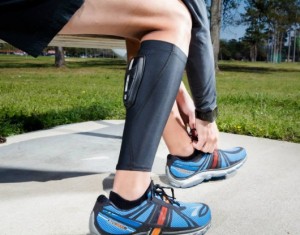It’s a wearable diagnostic testing device designed to allow athletes competing in strenuous sports to monitor lactic acid levels to guide training regimens
For two decades, healthcare policy experts have regularly predicted that a boom in consumer demand for clinical laboratory testing is just around the corner. Yet, in 2015, the Direct Access Testing (DAT) segment of the medical laboratory profession remains relatively small when measured by specimen volume and revenue.
Dark Daily believes that consumer interest in self-testing may actually be tapped by a different approach to diagnostic testing. It will come by serving the large number of athletes competing in triathlons, other strenuous sports, and extreme athletic events like 24-hour races. These athletes train hard and compete hard. They have disposable income and are willing to spend it on products and services that would improve their athletic performance.
Pathologists and clinical laboratory scientists will be fascinated to learn that one early product entry in this emerging category is a non-invasive test for lactic acid.
BSX Athletics of Houston, Texas, has developed a non-invasive, wearable device that monitors lactic acid levels in real time. The BSX device can share the results wirelessly with electronic devices carried by trainers and other athletes. Dustin Freckleton, M.D.,, Co-Founder and President of BSX Athletics, developed the BSXinsight for two purposes:
1. To analyze muscle oxygenation during each workout. This measures how stressful various routines are on the body and how fast the muscles recover after exercise. “Knowing what that recovery pattern looks like, you can know how long to rest or how hard to push yourself,” Dr. Freckleton explained in a dailyburn.com interview.
2. To continuously monitor the lactate threshold to see how it changes over time. Dr. Freckleton recommends users measure this every six to eight weeks.

Dustin Freckleton, M.D., developed the BSXinsight, which he claims is “the world’s first wearable lactate threshold sensor.” (Photo copyright LinkedIn.)
Device Determines Lactate Levels with Light
The BSXinsight consists of a wearable cuff and an electronic module. The athlete slips the stretchable cuff onto the calf. The electronic module, which sits in a pocket on the cuff, contains an LED array and a light detector. The array sends light into the muscle tissue, some of which is reflected back to the detector. Metabolic activity within the tissue affects the way the light is sent to the detector. By analyzing the light, the detector determines lactate levels in the muscle.
The other half of the process is the recording of the physical activity of the athlete. This happens when the athlete pairs the BSXinsight with a sports watch via Bluetooth or ANT+ (two wireless technologies that enable electronic devices to interact with each other). Thus, data can be shared with coaches and training partners.
According to BSX Athletics, the BSXinsight is 95% as accurate as blood tests. This was proven, they say, by testing 400 people while they were exercising. Blood samples were taken via finger sticks every two to three minutes, and lactate levels from these samples were compared with simultaneous readings provided by the device.
World’s First Wearable Lactate Threshold Sensor
BSX Athletics says the BSXinsight is the world’s first wearable lactate threshold sensor. Its purpose is to let athletes know how close they’re getting to “the edge,” a.k.a. the highest tolerable lactic acid level. Excess lactate may indicate hypoxia (a lack of oxygen), which causes increased lactate production and/or decreased clearance of lactate from the body. This can lead to Lactic acidosis—extremely high levels of lactic acid—which can be a life-threatening.

BSXinsight (pictured above) uses light to inform athletes when they should slow down or when it’s safe to work harder. (Photo copyright Gizmag.)
The Economics of the BSXinsight versus Clinical Laboratory Tests
In general, a lactic acid test or evaluation must be conducted in a performance laboratory and costs a minimum of $200. Small, portable self-test devices that provide lactic acid readings also are available, but they require a drop of blood as well as supplies (test strips and lancets) that must be continually replenished. The cost can be considerable.
Conversely, BSXinsight obtains readings without needles and provides results in real time. Prices vary from $200 to $419, depending on the model.
Affects of Self-monitoring on Pathology Groups and Clinical Laboratories
This is another example of how entrepreneurs are coupling diagnostic technology with computer analysis specifically to achieve a diagnostic answer without the need to use traditional medical laboratory methodologies. One feature that these innovative approaches have in common is that they are measuring biomarkers without the need for an invasive specimen collection.
The big question yet to be answered is will runners and other people who normally exercise strenuously buy this device? A positive market launch would demonstrate to pathologists and clinical laboratory managers how this segment of consumers are willing to spend their money to measure biomarkers they deem significant to their health or their lifestyle activity.
—E’Louise Ondash
Related Information:
BSXinsight Lactate Threshold Sensor Lets Athletes Know How Far to Push Themselves
Train Like the Elites with This New Lactate Threshold Tracker
Wearable Tech— BSX Monitors Lactate Threshold and Jaybird Reign Monitors the Rest
BSX Insight Fitness Tracker Is a Combination of Many Techs
Heart Rates Are Cool, But the BSX Insight Wearable Measures Lactate Threshold Too
A look at BSX Insight, a Bloodless Lactate Threshold Testing Device
BSX Insight Measures Athletic Horsepower, Wearable Athletic Sensor Pairs With Your Sports Watch
New In Vivo Implant Device Monitors Tumor Growth Remotely
Princeton Engineers Develop a Non-invasive Blood Glucose Test that Uses Imaging Technology



